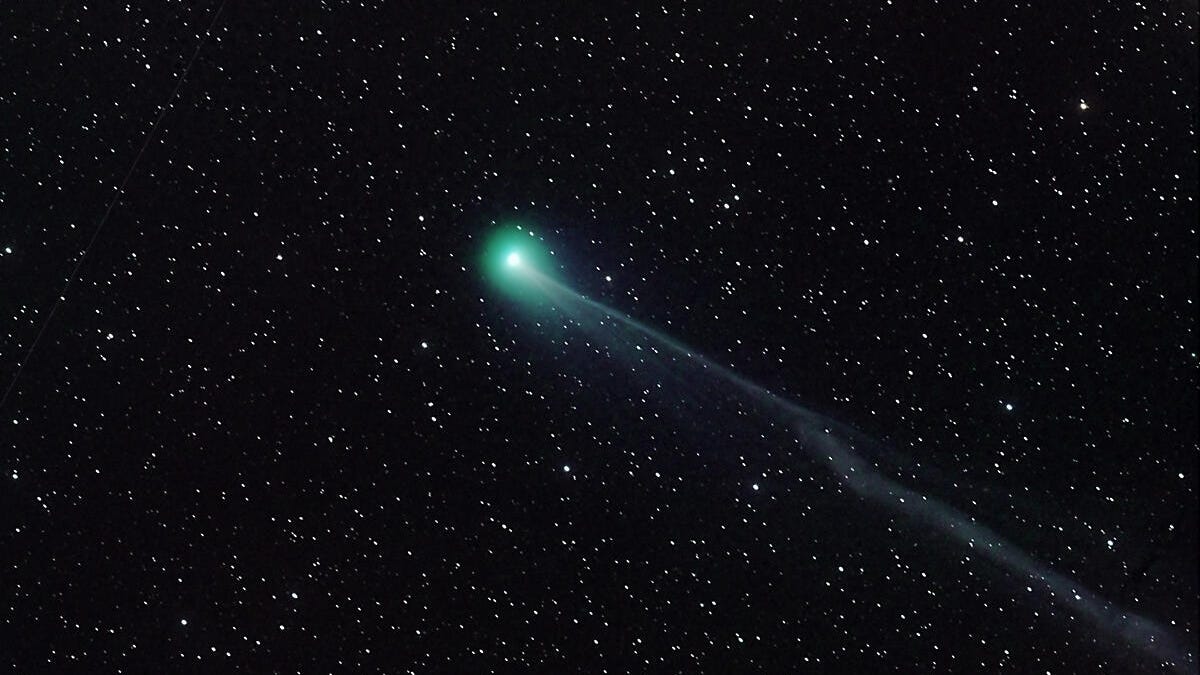Comets Swan and Atlas are cool, but might deliver a dangerous dusting
The space snowballs are a nice distraction, but could also be one more thing worth worrying about.

Comet C/2020 F8 SWAN, captured by Australia's Siding Spring telescope.
You've probably been a little too preoccupied during the tumultuous start to this year to notice that 2020 has also been a high-drama time for comets visiting the inner solar system. Right now, Comet Swan is visible to the naked eye and may grow even brighter as it rushes toward the sun over the next few weeks.
Comets like Borisov, Atlas and Swan have been a nice distraction from the coronavirus pandemic in recent months, but one scientist has warned that such spectacular space sights are also a potential threat when they start to crack up.
Comet Borisov is the first confirmed interstellar comet to visit our neighborhood. It was originally spotted last August and began to break up in early 2020 after swinging around the sun in December. About the same time, Comet Atlas brightened rapidly before breaking into pieces. Then there's Comet Swan, which passed by our planet with its nucleus intact but has a good chance of fragmenting as it races around the sun during the coming few weeks.
All this is great for skywatchers, astronomers and other space geeks, but the relationship between Earth and comets hasn't always been a cordial, arms-length affair. Just ask the dinosaurs. Many people believe the dinos were wiped out by a large comet impact that may've ignited massive fires, triggered huge tsunamis and kicked up enough particles to partially block out the sun and cool the planet.
William Napier from the Armagh Observatory in Northern Ireland argued in a paper first published last June that catastrophic consequences on Earth may not require a direct hit from a comet. Just drifting through the debris stream of a fragmented comet could also alter life on our planet in a major way.
"Such an encounter may have contributed to the large animal extinctions and sudden climatic cooling of 12,900 years ago, and the near-simultaneous collapse of civilizations around 2350 BC," Napier wrote in the Monthly Notices of the Royal Astronomical Society.
The earlier time Napier references is a period known as the Younger Dryas, when Earth suddenly shifted from a warming trend and slipped back into an ice age. One hypothesis for the abrupt climatic reversal is that an impact from a large comet or asteroid acted out a less memorable sequel of sorts to the impact that did in the dinosaurs.
This theory, however, is controversial and not universally accepted among scientists.
Napier suggested that a major impact may not have been required to change the climate.
"Sudden and extreme coolings ... may have arisen from comet dust sprinkling the upper atmosphere and reducing sunlight incident on the Earth's surface," he explained.
Napier created a model of a large comet that disintegrates as it travels through the inner solar system. He found that there's a chance Earth could experience one or more "meteor hurricanes" if it were to drift through that cloud of cosmic leftovers.
"Enough meteoric smoke may be created during such encounters to generate sudden coolings of some years' duration, along with widespread wildfires," Napier said.
He's basically describing a meteor shower from hell. And it's an idea other researchers have considered. Scientists have long suspected that the 1908 Tunguska Event, in which a mysterious force leveled a remote section of Siberian tundra, may've been caused by a wayward hunk of Comet Encke, which is also responsible for the beta Taurid meteor shower.
To be clear, no one is predicting that the remains of Comet Atlas or Borisov are on a collision course with Earth or about to usher in another ice age.
But comets are notoriously unpredictable. They're just big amalgamations of dust, ice, snow and rock that make a hobby of dive-bombing the sun. There's no way to tell what the fall out will be from such a high risk habit. Each time a comet visits our zone, it leaves behind new material that wasn't there before, and that our planet might end up interacting with.
We know such detritus creates awesome meteor showers every year, but it might also lead to major impacts every few decades, like the 2013 Chelyabinsk bolide or the Tunguska event. And every several thousand years or so, it may even cause more-drastic changes to our planet and our climate.
Fortunately, there should be some time to observe and study what this plentiful year for comets is leaving behind before we run into any of it. And that's a good thing. I don't think any of us wants to see what a meteor hurricane during our normal hurricane season in the midst of a pandemic looks like.

